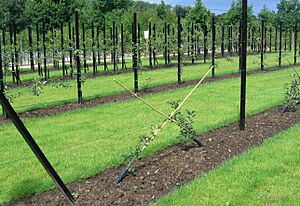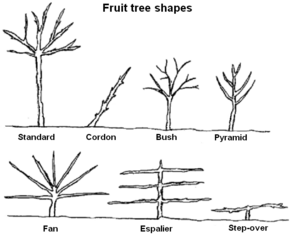Fruit tree forms facts for kids
Did you know that fruit trees can be grown in many different shapes? People shape fruit trees not just to make them look nice, but mainly to help them grow more fruit! We can change a tree's shape by carefully cutting its branches (this is called pruning) and by guiding how its branches grow (this is called training).
Shaping fruit trees helps them grow well in different places and conditions. It also helps them produce more fruit and better quality fruit. For example, if you shape a tree like a pyramid, you can plant many trees closer together. An open, bowl-like shape lets more sunlight reach the tree's leaves, which helps it grow lots of fruit. This shape also keeps the tree short, making it easier to pick the fruit. Other shapes, like cordons, espaliers, and fans, let you grow trees flat against walls or fences. They can even be trained to act like living fences!
Contents
Fruit Tree Shapes
Many fruit tree shapes need special training, like tying branches to guide their growth. Most also need regular pruning to keep their shape. Not all fruit trees can be grown in every shape. For example, apples and pears grow well as cordons and espaliers. Cherries, however, are usually better suited for a fan shape.
Bush Shape
A bush tree has a short trunk, usually less than 1 meter (about 3 feet) tall. Its branches spread out from the top, creating an open center. This is a very common and popular shape for apple trees. Bush trees are easy to take care of and start giving fruit when they are still young. Their final height can be between 2 meters (6.5 feet) and 5.5 meters (18 feet), depending on the rootstock (the part of the tree that grows underground and controls its size).
Standard Shape
Standard trees are much taller than bush trees. They have trunks that are 2 meters (6.5 feet) or more high. These trees can grow up to 8 meters (26 feet) tall! They eventually produce a lot of fruit, but because they are so large, they can be harder to manage and pick fruit from.
Pyramid Shape
The pyramid shape is similar to the bush shape, but the main central branch is allowed to grow much taller than the side branches. This makes the tree look like a pyramid.
Spindlebush Shape
The spindlebush is a special type of pyramid shape. In this form, the side branches are tied down so they grow horizontally (flat). This shape was created for orchards where many trees are planted close together. It is now the most popular way to train small apple and pear trees.
Cordon Shape
A cordon tree has only one main stem. It is usually planted at an angle, like 45 degrees. Small branches that produce fruit (called fruiting spurs) are encouraged to grow along this single stem. Any other side branches are removed by pruning. Cordons take up less space and produce fruit earlier than most other shapes. This means you can grow more types of fruit trees in a smaller area. However, each cordon tree produces less fruit than a larger tree.
Espalier Shape
An espalier tree has a central vertical (upright) trunk. From this trunk, three or four horizontal (flat) branches grow out on each side. These trees are often grown flat against a wall or fence.
Fan Shape
A fan tree has a short main trunk. From the top of this trunk, several branches spread out like a fan. This shape is often used for stone fruits like cherries and plums.
Step-over Espalier Shape
This is a type of espalier with only one layer of horizontal branches. These branches are grown very low to the ground, about 30 centimeters (1 foot) high. They make a fun and productive border for a vegetable garden.
Fruit Yield and Spacing
The amount of fruit a tree produces and how far apart trees need to be planted depends on their shape and type. Here are some examples for apples, pears, and other common fruit trees:
| Apples and pears | Yield | Spacing | ||
|---|---|---|---|---|
| Apples | Pears | In rows | Rows apart | |
| Bush | 25–50 kg | 20–45 kg | 4–5 m | 4–5 m |
| Dwarf bush | 15–25 kg | 10–20 kg | 2.5–5 m | 2.5–5 m |
| Dwarf pyramid | 5–7 kg | 3–5 kg | 1.5–2 m | 2 m |
| Espalier (two tier) | 10–12 kg | 7–10 kg | 3–6 m | 2 m |
| Fan | 5–15 kg | 5–15 kg | 4–5 m | - |
| Single cordon | 2–4 kg | 2–3 kg | 0.5–1 m | 2 m |
| Standard | 50–200 kg | 40–100 kg | 6–10 m | 6–10 m |
| Other tree fruits | Yield | Spacing | |
|---|---|---|---|
| In rows | Rows apart | ||
| Bush (sour cherry) | 15–20 kg | 4–5 m | 4–5 m |
| Bush (plum and peach) | 15–30 kg | 4–5 m | 4–5 m |
| Bush, standard (sweet cherry) | 15–50 kg | 5–12 m | 5–12 m |
| Fan (all stone fruits) | 7–15 kg | 4–5 m | - |
| Fan (sweet cherry) | 6–15 kg | 5–7.5 m | - |
| Pyramid (plum) | 15–25 kg | 3–4 m | 3–4 m |
| Standard (plum, peach and apricot) | 15–50 kg | 5–7.5 m | 5–7.5 m |
Images for kids














